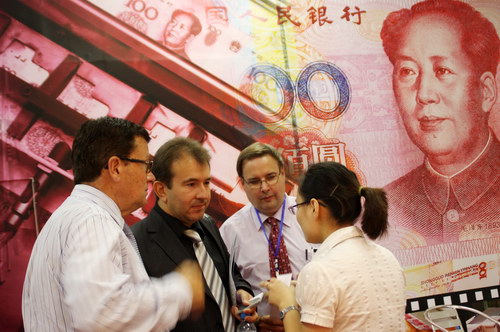-
News >Bizchina
Central bank plans overhaul of money policy
2011-02-11 09:14Measure would give broader view of liquidity, help fight against inflation
BEIJING - China's central bank is planning to use an indicator measuring total financing quantity and broader measures of money supply, such as M3 and M4, to better monitor liquidity conditions and curb inflation, local media reported on Thursday.
The People's Bank of China has already prepared a draft version of the reform, the Beijing-based newspaper China Securities Journal cited an anonymous source as saying.

People talking during an exhibition against the background of a renminbi note. China is considering reforming its liquidity measures to better control inflation. [Photo/China Daily]
The new indicators will widen the current M2, a broad measure of money supply that covers cash in circulation and all deposits, to total social financing, including yuan and foreign currency loans, entrusted loans, trust loans, bank acceptances, corporate bonds, equity financing, foreign direct investment and debts.
"The broader measures will redefine liquidity, and probably affect regulators' judgment on the inflation situation and monetary policy choices," it said.
The bank vowed in a report published on Jan 30 that it will strengthen control over total financing quantity this year to keep inflation at a stable level.
"In recent years, the diversification trend in China's financial structure has burgeoned. The proportion of direct financing has improved significantly, and off balance-sheet business of commercial banks showed a greater substitution effect to loans," it said in the report, vowing to pay more attention to total social financing.
Despite its "moderately" loose monetary policy adopted in 2008 to combat the fallout of the global financial crisis, China has been challenged by the problem of excess liquidity, which has resulted in surging inflation. In November, CPI rose to 5.1 percent, the highest in 28 months.
In 2010, new yuan loans exceeded the government's target of 7.5 trillion yuan ($1.1 trillion), rising to 7.95 trillion yuan, and M2 rose by 19.7 percent from the previous year, surpassing the official target of 17 percent. Over the same period, inflation jumped 3.3 percent year-on-year, exceeding the official 3 percent ceiling.
The inflation figure for January has yet to be disclosed but analysts expected it would reach a record high of somewhere around 5.3 percent.
As major economies tend to shore up their economy by maintaining an easy monetary stance, and large amounts of capital are flowing into emerging economies, the risks of rising inflation cannot be neglected, the central bank warned.
"Facing a new situation, the essence of a 'prudent' monetary stance (which China adopted in 2011) is to see how much capital the real economy can obtain, which means the social financing quantity should be regulated as a whole," said Xia Bin, economist and an academic member of the central bank's monetary policy committee.
Dong Xian'an, chief economist at Industrial Securities, said the old practice of regulating new yuan lending and M2 cannot meet the new requirements, as economic entities tend to raise funds directly and banks try to steer clear of credit control by developing off-balance sheet intermediary business.The new indicators would include all the funds raised by enterprises and individuals in the real economy over a certain period of time, the newspaper cited a source close to the PBOC as saying.
The country's total social financing increased 14.58 trillion yuan by the end of November, nearly double the total new lending of 7.47 trillion yuan at the same time, the newspaper said.
"The government should maintain the total quantity of social financing at 12 trillion yuan this year to keep a reasonable pace of economic expansion," said Lian Ping, chief economist at the Bank of Communications.
He said that adopting new indicators doesn't mean the usual measures, such as new yuan loans and M2, should be ignored. "After all, among social financing institutions, lending is still playing a major role."
Lian estimated that lending took up 75 percent of total financing while fundraising through stocks and bonds each accounted for 12.5 percent.
